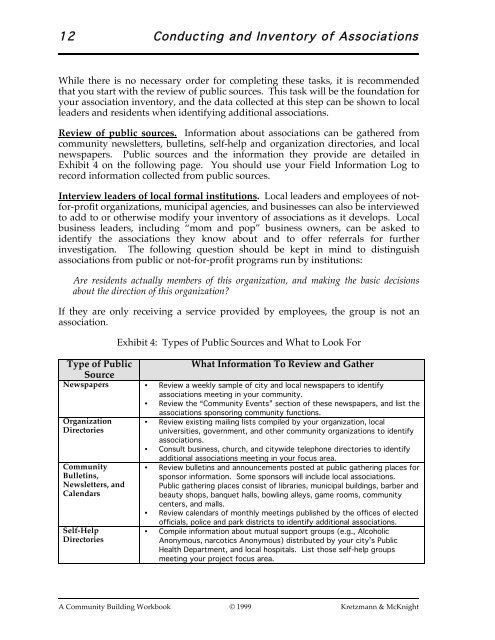A GUIDE TO MAPPING AND MOBILIZING THE ASSOCIATIONS IN LOCAL NEIGHBORHOODS
A GUIDE TO MAPPING AND MOBILIZING THE ASSOCIATIONS IN LOCAL NEIGHBORHOODS
A GUIDE TO MAPPING AND MOBILIZING THE ASSOCIATIONS IN LOCAL NEIGHBORHOODS
Create successful ePaper yourself
Turn your PDF publications into a flip-book with our unique Google optimized e-Paper software.
12<br />
Conducting and Inventory of Associations<br />
While there is no necessary order for completing these tasks, it is recommended<br />
that you start with the review of public sources. This task will be the foundation for<br />
your association inventory, and the data collected at this step can be shown to local<br />
leaders and residents when identifying additional associations.<br />
Review of public sources. Information about associations can be gathered from<br />
community newsletters, bulletins, self-help and organization directories, and local<br />
newspapers. Public sources and the information they provide are detailed in<br />
Exhibit 4 on the following page. You should use your Field Information Log to<br />
record information collected from public sources.<br />
Interview leaders of local formal institutions. Local leaders and employees of notfor-profit<br />
organizations, municipal agencies, and businesses can also be interviewed<br />
to add to or otherwise modify your inventory of associations as it develops. Local<br />
business leaders, including “mom and pop” business owners, can be asked to<br />
identify the associations they know about and to offer referrals for further<br />
investigation. The following question should be kept in mind to distinguish<br />
associations from public or not-for-profit programs run by institutions:<br />
Are residents actually members of this organization, and making the basic decisions<br />
about the direction of this organization?<br />
If they are only receiving a service provided by employees, the group is not an<br />
association.<br />
Type of Public<br />
Source<br />
Exhibit 4: Types of Public Sources and What to Look For<br />
What Information To Review and Gather<br />
Newspapers • Review a weekly sample of city and local newspapers to identify<br />
associations meeting in your community.<br />
• Review the “Community Events” section of these newspapers, and list the<br />
Organization<br />
Directories<br />
Community<br />
Bulletins,<br />
Newsletters, and<br />
Calendars<br />
Self-Help<br />
Directories<br />
associations sponsoring community functions.<br />
• Review existing mailing lists compiled by your organization, local<br />
universities, government, and other community organizations to identify<br />
associations.<br />
• Consult business, church, and citywide telephone directories to identify<br />
additional associations meeting in your focus area.<br />
• Review bulletins and announcements posted at public gathering places for<br />
sponsor information. Some sponsors will include local associations.<br />
Public gathering places consist of libraries, municipal buildings, barber and<br />
beauty shops, banquet halls, bowling alleys, game rooms, community<br />
centers, and malls.<br />
• Review calendars of monthly meetings published by the offices of elected<br />
officials, police and park districts to identify additional associations.<br />
• Compile information about mutual support groups (e.g., Alcoholic<br />
Anonymous, narcotics Anonymous) distributed by your city’s Public<br />
Health Department, and local hospitals. List those self-help groups<br />
meeting your project focus area.<br />
A Community Building Workbook © 1999 Kretzmann & McKnight


